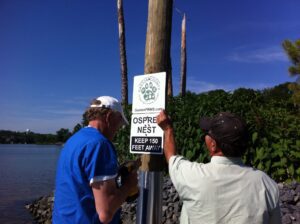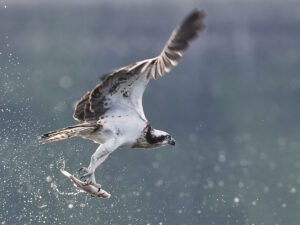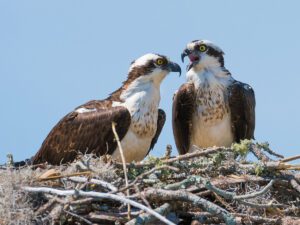Birds of a Feather – Famous Ospreys Return to Lake Norman Nesting Platform

Lake Norman’s most famous pair of ospreys have returned to their nesting platform for the spring! Fresh from their wintering grounds, the pair are getting busy preparing a nest for this year’s brood of young. And you can have a glimpse into their day-to-day lives, thanks to NCWF’s live video of the nest!
These two ospreys have been regular occupants of this same platform for the past six years, where they have repeatedly taken up residence to raise nearly a dozen chicks.
“This is a live view of nature, and we’ve certainly seen its wild side.” Says Billy Wilson of Lake Norman Wildlife Conservationists, “Crows have devoured eggs as another osprey, likely a returning juvenile from a previous brood, distracted the parents from the nest. We’ve seen the pair hunker down as 40-mile-per-hour winds threatened to ruin their perfectly constructed nest and the eggs it contained. But, no matter what the temp, we see their parental instincts on display as they work to keep their eggs and chicks warm when the nights drop to near freezing, and cool during afternoons that are blazing at over 90 degrees.”
A disappointment for viewers of the live video, the solar batteries that power the camera ran out of power halfway through the nesting season last year, meaning the last few months of the ospreys’ residence went unobserved. However, thanks to a grant from the Catawba-Wateree Habitat Enhancement Program and Duke Energy, the live cameras are loaded with fresh batteries that will hopefully last for years to come.
 But, it is not always necessary to wait for eggs to hatch to see new chicks in the nest; sometimes they are put there! Over the past seven years, NCWF nesting platforms have provided a safe haven for half a dozen osprey chicks that have been orphaned or separated from their parents.
But, it is not always necessary to wait for eggs to hatch to see new chicks in the nest; sometimes they are put there! Over the past seven years, NCWF nesting platforms have provided a safe haven for half a dozen osprey chicks that have been orphaned or separated from their parents.
However, just any nest will not do as there are several criteria that must be met before re-nesting a chick brought to the federation by the Carolina Raptor Center (CRC), a licensed rehabilitator. Most importantly, both parents must still be tending to the nest in order to best guarantee that the new arrival will be protected and fed.
The number of total chicks in the nest must also equal three or fewer in order to best ensure the newcomer will receive their fair share of nourishment. Limiting the number of total birds in the nest makes it less likely that the parents will be overburdened and reject the new addition.
Lastly, the osprey nest must be safely and quickly assessable by our volunteers. Three years ago, the nest featured on the live camera met all of these criteria when the CRC contacted NCWF in search of a new home for a chick separated from its parents. People across the world anxiously watched as the chick was carefully placed in the nest by CRC staff and NCWF volunteers. Over the next few months, viewers watched the pair of ospreys care for the new chick as if it was their own. Much to osprey cam viewers’ delight and amazement, the adoptive parents successfully raised the chick until it fully fledged.
Osprey Conservation Efforts
Osprey (Pandion haliaetus) are prevalent along the 225-mile long Catawba River running from western NC down into South Carolina, but this wasn’t always the case. As late as the early 1980s, osprey populations on the Catawba River, like in many places, were non-existent or
minimal at best. This was due to environmental factors, most notably widespread usage of the pesticide DDT, which weakens eggshells. Their numbers have significantly increased through a concerted effort to re-introduce osprey populations.
 Previously, osprey built nests in Lake Norman atop old navigational markers that were precarious and unsafe for eggs and chicks during heavy summer storms. Volunteers from NCWF, Lake Norman Wildlife Conservationists and Piedmont Area Wildlife Stewards replaced the markers with 30-foot poles with metal platforms attached and deployed by barge.
Previously, osprey built nests in Lake Norman atop old navigational markers that were precarious and unsafe for eggs and chicks during heavy summer storms. Volunteers from NCWF, Lake Norman Wildlife Conservationists and Piedmont Area Wildlife Stewards replaced the markers with 30-foot poles with metal platforms attached and deployed by barge.
The unencumbered height of the platforms is attractive to the birds while also protecting them against predators like black snakes and raccoons. Additional platforms are installed in Lake James, Mountain Island Lake, Lake Wylie and Lake Norman–all reservoirs of the Catawba River.
They provide nesting sites on large open bodies of water and healthy prey options, primarily live fish. Osprey will catch fish from the water using their long, hooked talons. An osprey can plunge so forcefully into the water that it will completely submerge. When carrying their prey back to the nest, osprey will arrange the fish so it’s facing upright head forward. Occasionally, they’ll catch and eat a snake, eel or even a frog.
The thriving osprey population on Lake Norman is a testament to the effectiveness of our mission to protect, conserve and restore the wildlife and habitats of North Carolina. Nearly all the platforms support nesting ospreys year after year. The young birds fledge in the summer and often migrate to Central and South America in the fall (the females usually leave about a month before the males), and they return to their nesting sites every March.

– Written by Bates Whitaker, NCWF Communications & Marketing Manager


